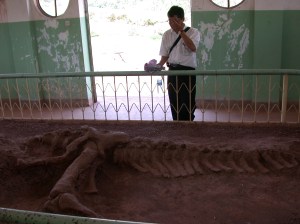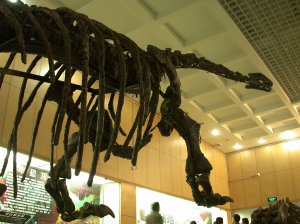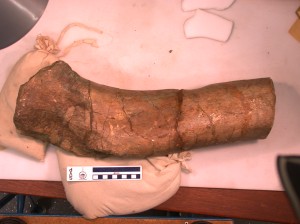The largest ‘prosauropods’. Part 2
OK time to get the countdown started. The list is ordered by femoral length, or extrapoloated femoral length, mostly because good skeletal reconstructions from which volumetric estimations could be made are lacking. Nevertheless the strong similarity of the body plan of basal sauropodomorphs means that femoral length is a pretty good proxy for body size. We’ll count down the top ten taxa.
Coming in at number ten we have:
Melanorosaurus readi with a maximum recorded femoral length of 63 cm.
Yes, that’s right. The archetypal ‘big prosauropod’ is actually quite a tiddler and barely scrapes into my top ten list. Nevertheless the individual elements of this guy are quite heavy and robust which may have fostered the myth that this near-sauropod was generally bigger than Plateosaurus and its ilk. It probably only tipped the scales at 800 kg.
9. ‘Lufengosaurus’ magnus. 74 cm
I put commas around the genus name because no-one has proposed any good characters that might link L. magnus to L. huenei even though they are fairly universally treated as synonyms. They could be but I doubt it, there are some odd features of L. magnus that are not present in L. huenei and vice versa.

A partial skeleton of what might be 'Lufengosaurus magnus' left in situ on Dawa Hill, near Lufeng, Yunnan.
8. Jingshanosaurus xinwaensis. 75 cm
Not the largest basal sauropodomorph by any means but it does include the largest nearly complete mounted skeleton of a basal sauropodomorph.
7. Plateosauravus cullingworthi. Estimated 83 cm
This is the taxon that has been farly consistently confused with Euskelosaurus since the 1970’s. It isn’t. The known femora of Plateosauravus are not so big, but there are other bones included in the topotype collection that indicate that some members of this species got quite large. Scaling up from these bones we arrive at an estimated femoral length of 83 cm for the biggest individuals in the topotype bone bed. Based on other basal sauropodomorphs we can estimate that an individual with an 83 cm femur would have weighed in at 1.1 to 1.2 tons.
6. Euskelosaurus browni. Estimated 85 cm
Regardless of whether or not this is a nomen dubium the individual upon which the name was bestowed did exist, and was pretty large. Further it demonstrably didn’t belong to any of its well-known contemporaries such as Antetonitrus, Melanorosaurus, Eucnemesaurus or Plateosauravus so provisionally, I’m treating this as a valid taxon.
So oddly enough places 10-6 consist entirely of taxa either from the Early Jurassic of China or the Late Triassic of South Africa. Another take home point is that a lot of these measurements are based on very limited sample sizes. Given the rather small differences between many of them it would be silly to treat this list as accurately reflecting the mean sizes of each of these species, or the top sizes that they reached. Nonetheless the very biggest on the list were in a real biological sense large animals than those from the bottom of the list. What were the top five? You’ll have to wait for part 3.
A note on missing taxa. I could get only get skull measurements for Yimenosaurus, so it is not included. Chinshakiangosaurus, Antetonitrus and Lessemsaurus are arbitrarily excluded on suspicion of being sauropods.



Recent Comments